██████╗ ██╗ ██████╗ ██╗ ██████╗ ██╗ ██╗
██╔══██╗██║██╔════╝ ██║ ██╔══██╗╚██╗██╔╝
██║ ██║██║██║ ███╗██║ ██║ ██║ ╚███╔╝
██║ ██║██║██║ ██║██║ ██║ ██║ ██╔██╗
██████╔╝██║╚██████╔╝██║ ██████╔╝██╔╝ ██╗
╚═════╝ ╚═╝ ╚═════╝ ╚═╝ ╚═════╝ ╚═╝ ╚═╝
RSID: <<2016-09-
19T20:00Z
MFSK-32 @ 6070000+1500>>
Hello and welcome to DigiDX 29 a weekly review of the latest shortwave
and DX news today in MFSK32 mode. This programme includes the latest
shortwave news, a review of the Tecsun PL-365/CountyComm GP-5 by Jay
Allen and the e-QSL card.
DigiDX weekly schedule:
Sunday 2130 - 15770kHz via WRMI
(Okeechobee, FL, USA)
Sunday 2330 - 11580kHz via WRMI (Okeechobee, FL, USA)
Sunday 1830 - 6070kHz via Channel 292 (Rohrbach Wall, DE)
Monday 2000 - 6070kHz via Channel 292 (Rohrbach Wall, DE)
To buy shortwave airtime from Channel 292 at very reasonable prices go
to http://www.channel292.de or from WRMI
from http://www.wrmi.net/
Any other extra broadcasts will be listed on
http://www.digidx.uk
If you enjoy DigiDX and find the service useful please consider donating
via Paypal to reports@digidx.uk. Any
money donated will go towards
paying for airtime to keep DigiDX on the air to Europe and North
America.
Latest Shortwave News:
ABC Australia Northern Territory returns
Last week on DigiDX we reported on ABC’s Northern Territory shortwave
stations being off the air and rumours that they were to close down.
Thankfully as mentioned to some listeners in an email from ABC, all
three stations came back on air on Tuesday 13th September and were heard
as early as 0400 UTC instead of the suggested 2100UTC return time.
The following frequencies are used for the 3 stations broadcast on
shortwave and aimed at the Australian Northern Territory.
Alice Springs - 0000-2359 on 4835khz
Tennant Creek - 0830-2130 on 2325kHz / 2130-0830 on 4910kHz
Katherine - 0830-2130 on 2485 KTH / 2130-0830 on 5025
Upcoming relays and special broadcasts:
VOA Radiogram will be on air this weekend on the following frequencies, for more
information on the modes to be used visit http://voaradiogram.net/
Sat 0930-1000 5745 kHz
Sat 1600-1630 17580 kHz
Sun 0230-0300 5745 kHz
Sun 1930-2000 15670 kHz
After a summer break Gilles Létourneau who runs the excellent OfficialSWLchannel
channel on Youtube is back with with his shortwave and radio related Youtube
Live shows.
To watch the shows or any of his videos go to
https://www.youtube.com/user/OfficialSWLchannel
Tecsun PL-365/CountyComm GP-5/SSB AM/FM/SW
Radio With SSB
review by Jay Allen from
https://radiojayallen.com
The Tecsun PL-365/CountyComm GP-5/SSB looks almost identical to the
earlier PL-360/GP-5-DSP but has been redesigned internally and is in
fact built around a new chip, the SiLabs Si 4735 (the earlier models
used the Si 4734). The new model adds SSB which was a prime requirement
on the part of CountyComm who commissioned Tecsun to re-design the radio
to meet the needs of government agencies for a small, inexpensive but
good quality HF Communications receiver. There have been other
enhancements added as well, including SW coverage all the way up to 30
MHz and extended battery life, which is claimed to be 225 hours on a set
of three Alkaline AA cells. The radio will also internally recharge
rechargeable batteries from any USB connection although no batteries are
supplied with either the Tecsun or CountyComm’s version. The only
apparent differences between the CountyComm versus Tecsun branded
versions appear to be cosmetic ones…the color of the antenna tip and
Tuning thumbwheel.
General Specifications & Features:
The PL-365/GP-5/SSB is designed for easy one-handed operation in the
style of a walkie-talkie. It comes with a unique plug-in rotating
ferrite rod antenna for AM and LW, a wire antenna for SW, a belt clip,
padded carry pouch with belt loop, ear buds and Owner’s Manual.
Frequency Coverage:
FM 76 – 108 MHz, 87-108 MHz, 87.5-108 MHz (Selectable)
LW 150-519 KHz
AM(MW) 520 – 1710 KHz
SW 1711 – 29,999 KHz in 14 Bands (120M, 90, 75, 60, 49, 41, 31, 25, 22, 19, 16,
15, 13, 11)
SSB SW Bands: (160M, 80, 40, 30, 24, 20, 17, 15, 12, 10)
Size: 2 x 6 x 3/4″ 4.4 oz without batteries
450 memories – 100 AM, 100 FM, 250 SW Plus 100 ETM memories for temporary
scanning storage such as when travelling…very handy indeed.
Tuning is via a thumbwheel with Up/Down Band Selection buttons and ETM Tuning
and there is an analog volume thumbwheel on the right side as well.
FM Tuning Steps 0.1 MHz (Fast), 0.01 MHz (Slow)
AM (MW) Tuning Steps 9/10 KHz selectable or 1KHz Slow Mode
LW 9/1 KHz Tuning Steps
SW Tuning Steps 5/1 KHz
SSB Fine Tuning Steps 50Hz, 20 Hz, 10 Hz
Uses 3 AA Batteries and can recharge Ni-MH batteries in the radio
(batteries not supplied) via mini USB input
LCD Display of Frequency, FM Stereo, Battery level, Charging indicator,
Signal Strength, Signal to Noise ratio, Temperature, Alarm, Sleep Timer,
SW Band, Memory Address, ETM, Key-Lock etc.
CountyComm of Sunnyvale, CA designs and supplies specialized products
for local, state and federal agencies. They work directly with Silicon
Labs (DSP chip manufacturer) and Tecsun and are the sole US importer of
these models…even Kaito USA which is the US Importer of Tecsun radios
shows only the older PL-360 on their site. It is possible that once
CountyComm’s order has been fulfilled, Tecsun or Kaito versions may
begin to appear at Kaito US and the Tecsun version at the usual eBay
sites but so far only the older non-SSB model is thus available. My
review sample was provided to me by the great folks at Tecsun Australia
who tell me they will gladly ship anywhere in the world. (See link at
end of review).
20151208_150059_006 CROP VerticalIn Use: The PL-365 is quite different
than the traditional portables we have become accustomed to. The entire
concept of one-handed operation makes for a completely different user
experience. Again, think “Walkie-Talkie”without the “Talkie” and
you’ll get it. The PL-365 conjures images of special ops forces trying
to ferrite a criminal from his hiding place. Once you are comfortable
with this kind of operation the radio begins to feel natural…and kind
of cool! Initially I found the radio a bit awkward to get from here to
there quickly in the SW bands since there is no keypad for direct
frequency input. Even with the Up/Down band buttons which divide SW into
14 bands (and a separate group of 12 Ham Bands in SSB mode) , you can do
lots of thumb-wheeling to get from one end of a band to the other. But
after using it for a while I discovered ways to make frequency hopping
easier and more intuitive. The most obvious is to use frequency presets
at strategic frequencies, from which you can then tune up or down easily
to get to your desired frequency. Also the ETM (Easy Tuning Mode)
function on this radio is helpful because it does not disturb your
regular presets…the ETM has its own, temporary 100 station memory
which is perfect for travelling to new areas where you can quickly
populate that memory bank with receivable signals in that location
leaving all your other 450 presets untouched…very convenient.
The tiny speaker offers minimal audio quality…this radio is clearly
designed for voice communications and with the included earbuds you can
have both privacy and better quality audio when needed..even FM Stereo.
Rotating AM Ferrite Rod Antenna: OK. I’ll admit that at first I
thought it strange to incorporate a rotating ferrite rod AM antenna on a
radio this small..after all, why not just turn the whole radio? But
after seeing how small the radio is and actually using it I realized
that its main purposes are to allow a larger ferrite rod than that which
would fit inside the radio, plus the ability to remove it completely to
make the radio even smaller when it isn’t needed – you can still
pick up strong local AM signals without it. When it is installed you can
rotate it out of the way to extend the whip antenna.
20151208_150116_001 VerticalPerformance: Here’s where the rubber meets
the road. Because it is central to the design objective for this radio I
concentrated on SW performance first. I compared the PL-365 with several
popular portables and it was competitive, fairing slightly better than
the many under $60 radios and slightly less well than radios in the
general $125 – $200 price range. SW sensitivity was a hair less than
the larger Tecsun Portables such as the PL-660-, PL-680 and PL-880. The
PL-365 performed at its best as long as I was holding the radio in my
hand…some signals were weaker when I set the radio down so evidently
hand capacitance is important here…not unusual with smaller portables.
As expected sensitivity was much better using the supplied clip-on wire
antenna. The ETM function was very helpful finding listenable SW
signals. Selectivity was good…I had no trouble separating most SW
signals from nearby ones on the dial.
Interestingly the PL-365 has two filter bandwidth options…a wide
filter (I would guess it to be about 6 KHz) and a narrow filter (I’d
guess perhaps 2.5-3 KHz) which is automatically switched in when you
enter SSB mode. While purists might argue that it would be nicer to have
manual control over the two bandwidths in both modes, the other side of
the coin is that this is an elegant way to simplify one-handed
operation.
SSB Mode was an important part of the PL-365’s design and considering
the one-handed design of the radio Tecsun has done an incredible job of
making SSB tuning as precise and easy as can be – it actually works
quite well once you get used to it. From SW mode press the USB/LSB
button and after a few seconds you will see a “U” indicating that
you are in Upper Sideband mode, or USB. Press it again to toggle to
Lower Sideband mode and an “L” will display. Now the Up/Down buttons
will scan the amateur (Ham) bands. Once you are tuned to a signal hit
the BFO Button and fine tune with the tuning thumbwheel for most natural
audio. Another press of the USB button exits SSB mode. In SSB mode the
bandwidth is narrowed as I mentioned above and a new set of 12 meter
bands are selectable.
The SSB Fine Tuning increments of 50, 20 or 10 Hz are selected while the
radio is off but generally you will find one setting which you prefer
and leave it there. The default 50 Hz setting is fine enough to achieve
decent results…of course as you decrease the increments to 20 or 10 Hz
you gain finer control at the expense of a bit more thumbwheel turning.
I ended up setting mine to 20 Hz – which setting you choose will
depend largely on how you use the radio. Overall I found the PL-365 to
be relatively easy to tune for natural sound on SSB. Some other radios
with variable RF Gain might provide cleaner SSB audio recovery in some
cases…a work-around with stronger signals is to try lowering the whip
a bit. Again this radio was designed for small size, reliable SSB
communications in the field so some compromises are inevitable compared
with less-portable radios.
AM Reception was better than I had expected. Although Tecsun’s current
radios are somewhat noisy on AM, the PL-365 actually outperformed the
larger PL-680 on AM with slightly better sensitivity and less background
hiss on weaker signals. It was only a hair less sensitive than the
PL-660 and PL-880 on AM which for this size radio is great performance.
You can still receive strong AM signals with the ferrite bar removed but
you’ll want to keep it handy for any real AM reception.
UPDATE: After-Market Accessory 8″ Ferrite Rod Antenna:
There is an after-market accessory 8” ferrite rod available for about
$40 plus shipping that significantly improves the radio’s AM
performance. The seller has an online video which shows dramatic
improvement on two frequencies. I obtained one of these antennas and it
does significantly boost the AM reception capability as you would
expect, raising the PL-365 from *1/2 Stars to ** Stars in my AM Mega
Shootout ratings. Interestingly though the improvement is not consistent
across the band…it varies from frequency to frequency. As per my usual
methodology when rating radios I scanned the entire AM band at midday
and tabulated the performance of the original ferrite against the longer
ferrite on over 30 frequencies between 540 – 1700 KHz. The results
were interesting.
On many frequencies the signal level indicator on the radio showed
markedly higher readings and improved S/N ratio along with greatly
improved audio recovery. But on other frequencies the readings were
actually poorer with the longer rod and the reception was audibly less
strong. Even more interesting, on other frequencies the signal readings
did not correlate with what I was hearing, with poorer numerical
readings but improved audible reception, or vice versa.
Here are my main conclusions:
First, the longer ferrite rod does indeed provide improved reception on
many stations, but there were some that were actually better with the
shorter ferrite rod.
Second, the radio’s signal level and s/n meter readings didn’t
always correlate with what I was hearing. Usually they did but not
consistently. I suspect this is simply the fact that these meter
readings are not terribly accurate under all conditions, but it is
possible that something in how the longer ferrite matches the radio’s
input is at play.
But it doesn’t really matter…the longer antenna does provide
improved reception on many if not most signals and is a worthwhile
investment if you plan to use your PL-365 on AM.
FM Reception was very good overall. Comparing it with other portables
the PL-365 made a good showing with excellent FM selectivity and capture
ratio along with good to very good sensitivity. It also provides Stereo
(switchable to mono) at the earphone jack. I wouldn’t rate it as the
very best audio quality as it was somewhat bandwidth limited and there
are no tone controls but for general listening it is fine.
Other Characteristics: The PL-365 has the same Fast/Slow tuning feature
found on many of Tecsun’s other radios which changes tuning steps
based on how fast you tune. You have to learn the feel of it or it can
be a bit unpredictable. Using AM as an example, as you begin to tune it
will be start in Slow mode, progressing from, for example, 770 to 771,
772, 773. Once you reach 780 if you continuously tune it will switch to
Fast mode (10 KHz steps) and progress to 790, 800, 810 etc. But if you
hesitate for a moment it will revert back to 1KHz steps then switch back
to Fast mode if you keep tuning. It can actually be very handy once you
get the feel of it…it is not defeatable on the PL-365. The radio also
mutes briefly while tuning which makes band scanning less enjoyable than
it is on radios that don’t mute…common with many DSP radios these
days and something the manufacturers will hopefully soon learn to
eliminate. It does release very quickly on the PL-365 however which is a
help so if you tune slowly enough you can hear what you’re passing
over. (Many early digital radios made noises [known as “chuffing”]
or muted themselves while tuning. Later designs eliminated this and gave
us digital radios that tune as smoothly and seamlessly as old analog
radios used to. Now the newest crop of DSP designs have given us great
improvements in manufacturing cost, features, performance and
unit-to-unit consistency but they also can take time to produce audio
when you change frequencies…I’m hopeful it will eventually be
eliminated completely).
Conclusion: The Tecsun PL-365 is a bit difficult to compare with other
multi-band portables because its “one-handed” form factor is so
unusual. Certain design decisions were clearly made to enhance ease of
use, yet it’s overall performance is excellent for the size and price.
Most smaller radios are held while being tuned or carried around but
they are generally operated with both hands, or placed on a desk or
table. The PL-365 definitively changes all this with a tactical design
which almost expects to be held full time as you would a walkie talkie.
Once you accept that it becomes apparent that its layout and design were
carefully considered and well executed. For example, the lack of a
keypad is definitely a hindrance to ease of tuning, yet the general
shape and layout of the radio make one-handed tuning as easy as
possible. For many users that fact alone will make the PL-365/CountyComm
GP-5/SSB well worth the price of admission…it is a unique product!
See It At Tecsun Australia (will ship worldwide) -
http://bit.ly/RJAPL365
In The U.S. see it at CountyComm -
http://www.countycomm.com/gp5ssb.html
or
Universal Radio -
http://www.universal-radio.com/catalog/portable/0905.html
For the full review with images go to
https://radiojayallen.com/tecsun-pl-365countycomm-gp-5ssb-amfmsw-radio-with-ssb/
Now follows the e-QSL card sent as an MFSK32 image....
Sending Pic:466x266;
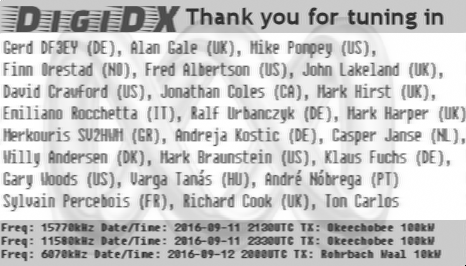
Thank you for
listening, please send reports, comments and shortwave
related news or articles to reports@digidx.uk. This is DigiDX Signing
off.....
██╗ ██╗██████╗ ██████╗ ██████╗ █████╗ ██████╗ ██╗ ██████╗ ██████╗ ██████╗ █████╗ ███╗ ███╗
██║ ██╔╝██╔══██╗██╔════╝ ██╔══██╗██╔══██╗██╔══██╗██║██╔═══██╗██╔════╝ ██╔══██╗██╔══██╗████╗ ████║
█████╔╝ ██████╔╝██║ ██████╔╝███████║██║ ██║██║██║ ██║██║ ███╗██████╔╝███████║██╔████╔██║
██╔═██╗ ██╔══██╗██║ ██╔══██╗██╔══██║██║ ██║██║██║ ██║██║ ██║██╔══██╗██╔══██║██║╚██╔╝██║
██║ ██╗██████╔╝╚██████╗ ██║ ██║██║ ██║██████╔╝██║╚██████╔╝╚██████╔╝██║ ██║██║ ██║██║ ╚═╝ ██║
╚═╝ ╚═╝╚═════╝ ╚═════╝ ╚═╝ ╚═╝╚═╝ ╚═╝╚═════╝ ╚═╝ ╚═════╝ ╚═════╝ ╚═╝ ╚═╝╚═╝ ╚═╝╚═╝ ╚═╝
|
http://www.kbcradio.eu/
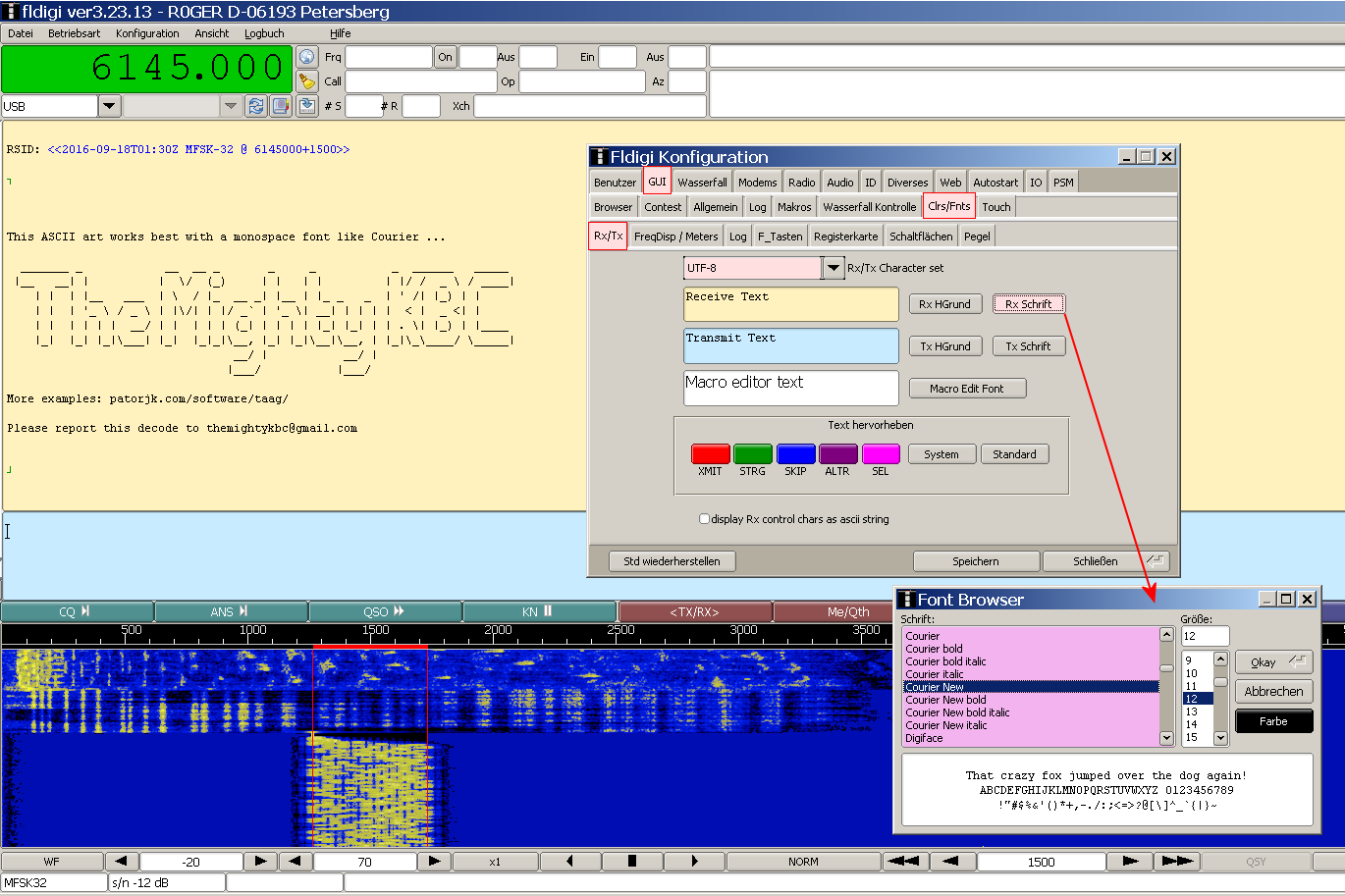
██╗ ██╗ ██████╗ █████╗ ██████╗ █████╗ ██████╗ ██╗ ██████╗ ██████╗ ██████╗ █████╗ ███╗ ███╗
██║ ██║██╔═══██╗██╔══██╗ ██╔══██╗██╔══██╗██╔══██╗██║██╔═══██╗██╔════╝ ██╔══██╗██╔══██╗████╗ ████║
██║ ██║██║ ██║███████║ ██████╔╝███████║██║ ██║██║██║ ██║██║ ███╗██████╔╝███████║██╔████╔██║
╚██╗ ██╔╝██║ ██║██╔══██║ ██╔══██╗██╔══██║██║ ██║██║██║ ██║██║ ██║██╔══██╗██╔══██║██║╚██╔╝██║
╚████╔╝ ╚██████╔╝██║ ██║ ██║ ██║██║ ██║██████╔╝██║╚██████╔╝╚██████╔╝██║ ██║██║ ██║██║ ╚═╝ ██║
╚═══╝ ╚═════╝ ╚═╝ ╚═╝ ╚═╝ ╚═╝╚═╝ ╚═╝╚═════╝ ╚═╝ ╚═════╝ ╚═════╝ ╚═╝ ╚═╝╚═╝ ╚═╝╚═╝
╚═╝
http://voaradiogram.net/
<<2016-09-17T1601-1630z
@
175800000+1500>>
|
Hallo Roger,
5 kurze Senderausfälle habe ich registriert:
[17580 kHz]
gegen: 16:14:30z
16:17:15z
16:18:45z
16:20:15z
16:20:25z Gruss Frank |
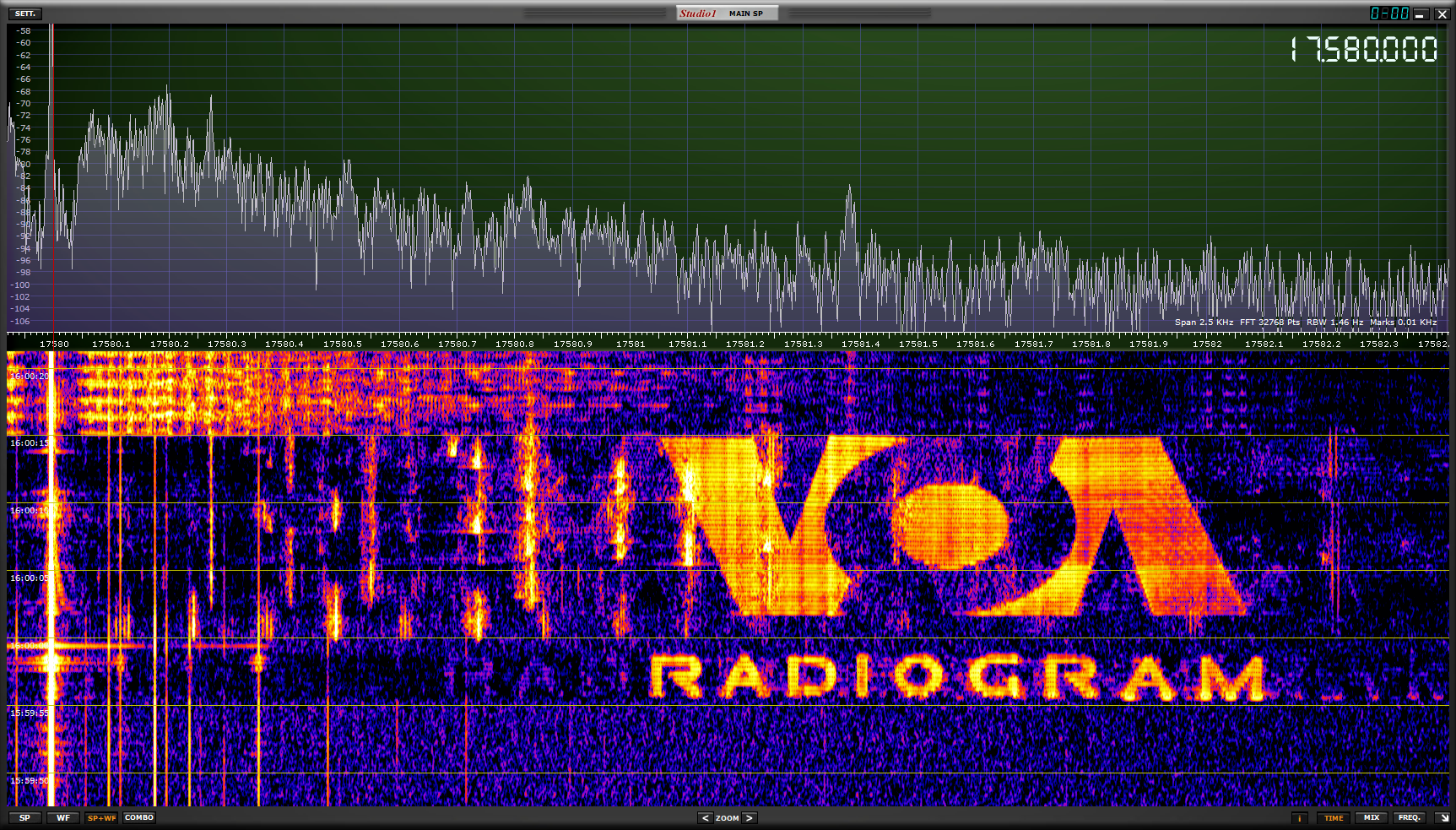

RSID: <<2016-09-18T19:31Z
MFSK-32 @
15670000+1500>>
Welcome to program 181 of VOA Radiogram from the Voice of
America.
I'm Kim Andrew Elliott in Washington.
Here is the lineup for today's program, all in MFSK32 centered on
1500 Hz:
1:39 Program preview (now)
2:49 Pluto "spray paints" its moon Charon*
7:07 China launches space lab into orbit*
10:20 NASA mission hopes to collect asteroid samples*
19:05 Peptide polymers fight resistant infections*
23:08 Image and closing announcements*
* with image
Please send reception reports to radiogram@voanews.com.
And visit voaradiogram.net.
Twitter: @VOARadiogram
Study: Pluto 'Spray-painting' Poles of its Big Moon Charon
Associated Press via voanews.com
September 14, 2016
CAPE CANAVERAL, FLORIDA - A new study finds that Pluto is
"spray-painting" the red poles of its big moon Charon.
The paint is actually Pluto's continually escaping atmosphere.
Methane and other gases from Pluto end up coating Charon's frozen
poles, which are so cold and where winters are so long that this
buildup remains for decades. A chemical transformation, via solar
radiation, turns the polar caps dark red.
Planetary scientist Will Grundy of Lowell Observatory in Arizona
bases his findings on observations by NASA's New Horizons
spacecraft. He says it's a new phenomenon for scientists and akin
to "spray-painting."
His study was reported by the journal Nature on Wednesday, 16
months to the day after New Horizons' historic flyby of Pluto.
http://www.voanews.com/a/study-pluto-spray-painting-poles-moon-charon/3509988.html
Image: This composite of enhanced color images shows Pluto (lower
right) and Charon (upper left), taken by NASA’s New Horizons
spacecraft as it passed through the Pluto system on July 14, 2015
...
Sending Pic:266x161C;

This is VOA Radiogram from the Voice of America.
Please send reception reports to radiogram@voanews.com.
China Launches Space Lab into Orbit
VOA News
September 15, 2016
China has launched its second space laboratory into orbit
Thursday, in a step towards having its own manned space station.
The Tiangong-2, or Heavenly Palace-2, lifted off from China's
launch center in the Gobi desert.
The Xinhua news agency said it will be followed by a mission to
carry two astronauts to the space lab in mid- to late-October for
30 days.
China will send its first cargo ship to the lab in April. A fully
functional space station is envisioned by 2022.
The 8.6 ton Tiangong-2, measuring about 10 x 3 meters, replaces
the Tiangong-1 launched in 2011 and will orbit at a height of
393-kilometers above the earth.
http://www.voanews.com/a/china-launches-space-lab-into-orbit/3510432.html
See also:
http://www.voanews.com/a/china-launch-second-space-lab-manned-mission-october/3509452.html
Sending Pic:213x130C;
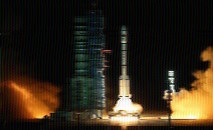
This is VOA Radiogram from the Voice of America.
Please send reception reports to radiogram@voanews.com.
NASA Hopes to Catch an Asteroid
Kevin Enochs
September 14, 2016
If all goes well, NASA will launch one of its most audacious
missions in less than a decade.
It's called the Asteroid Redirect Mission (ARM). NASA and White
House officials gave an online preview of the mission and also
explained how it folds into the larger goal of getting humans to
Mars.
ARM is a robotic spacecraft that officials hope will be launched
into space in the next few years and make its way to a
"near-Earth asteroid." To that end, the mission is similar to the
OSIRIS-REx mission that was launched last week and is headed
toward the potentially dangerous asteroid Bennu.
But ARM is much larger in scale, and will be testing a number of
new NASA technologies that will be part of the greater manned
Mars mission.
'Solar electric propulsion'
The engines on the ARM spacecraft represent the first big step
forward. They employ a new propulsion system called Solar
Electric Propulsion (SEP), which will use the energy of the sun
to create electromagnetic fields that will "accelerate and expel
charged atoms" to push ARM toward the asteroid.
SEP uses a lot less chemical propellant than the engines NASA
used on the shuttle, for instance.
ARM will land on the selected asteroid to collect samples, which
NASA scientist Michele Gates said may be as much as 20 percent
water. The asteroid's makeup will help in the continuing study of
the early days of our solar system, and Gates says the samples
could be "volatile rich," containing nitrogen, carbon dioxide and
ammonia.
Altering asteroid's orbit
The planned landing site is directly on top of a boulder, perhaps
as heavy as 20 tons. The spacecraft will wrap three metal arms
around the big rock, lift it off the surface and blast back off
into space.
And then, in a test of technology NASA administrator Charlie
Bolden said would prove that we're "smarter than the dinosaurs,"
the ARM spacecraft will attempt to alter the trajectory of the
asteroid. It is a test to see if we can avoid getting hit by a
massive asteroid like the one that struck Earth millions of years
ago and ended the age of the dinosaurs.
The ARM spacecraft, now dragging the huge boulder, will spin
around the asteroid, NASA says, and use "the mass of the
spacecraft [and boulder] to impart a gravitational force on the
asteroid, slowly altering the asteroid's trajectory."
If it works, it could prove the simplest way to protect our
planet from what Bolden called "those one-in-a-century" asteroid
events like the 1908 Tunguska meteor that exploded in the
atmosphere and flattened 2,000 square kilometers of forest in
Siberia.
Moon gets its own satellite
Once ARM is done with that attempt to change the orbit of a large
body in space, it will head back towards the earth and deposit
the boulder it's been carrying in a safe orbit around the moon.
The boulder would simply burn up in the atmosphere if it were to
accidentally fall to earth.
Once the boulder is circling the moon, sometime in the 2030's,
NASA will send a manned mission to collect samples from it using
the new Orion spacecraft, and bring them safely back to Earth.
This mission and the technologies created by it could open the
way for what Bolden calls the potentially lucrative commercial
mining of asteroids.
The ARM mission accomplishes another important step in our
movement into space, while testing Solar Electric Propulsion, the
Orion spacecraft, and a new space launch system for the Mars
mission.
Preparing for Mars
NASA Administrator Bolden calls it the second phase of our
journey beyond Earth. The first is what he calls "the Earth
reliant phase," where everything we do in space starts and ends
on Earth.
This new generation of spacecraft will establish us in what he
calls a cis-lunar phase, where we can use a stable orbit around
the moon and its gentle gravity as a jumping off point for any
missions beyond Earth. In the final "earth-independent" phase of
planning to go to Mars, Bolden says, we either "need to take
stuff with us, get it on the way or make it wherever you go."
Bolden says that third phase is so close he can taste it. And if
the timeline stays on target and the expected $1.4 billion worth
of funding gets approved, we might have a new rocky neighbor
orbiting the moon within a decade.
http://www.voanews.com/a/nasa-asteroid-redirect/3509285.html
Image: Screen capture from accompanying video ...
Sending Pic:214x154C;
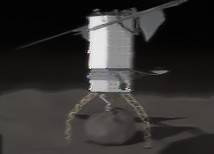
This is VOA Radiogram from the Voice of America.
Please send reception reports to radiogram@voanews.com.
A New Way to Fight Superbugs
Rick Pantaleo
VOA Science World Blog
September 14, 2016
Scientists in Australia may have come up with a unique solution
to fight antimicrobial resistant infections or superbugs, a
growing worldwide health concern.
The researchers found that star-shaped objects they created with
short chains of proteins called 'peptide polymers' might be able
to replace traditional antibiotics.
Doctors have long prescribed antibiotics to fight various
bacteria borne ailments from acne to pneumonia.
But using these drugs repeatedly over time can cause many of
these microbes to mutate and build a resistance against
medications made to fight them.
After testing their star-shaped peptide polymers on animal
models, the researchers found them to be effective in killing
superbugs.
They also discovered that antibiotic resistant microbes showed no
signs of fighting this new treatment method, suggesting that it
might be more difficult for microbes to mutate like they have to
antibiotics.
http://blogs.voanews.com/science-world/2016/09/14/light-not-shock-restarts-heart-bees-nest-in-sandstone-5-second-rule/
Image: Scanning electron micrograph of the superbug
Staphylococcus aureus or MRSA ...
Sending Pic:224x148C;

Image: A man fishes from his boat as fog rises over the lake in
the town of Logoisk, 40 km north of Minsk, Belarus ...
Sending Pic:369x234;
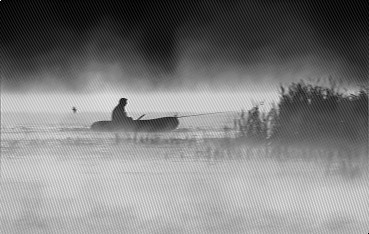
http://www.voanews.com/a/september-15-2016-day-in-photos/3510712.html
Please send reception reports to radiogram@voanews.com.
And visit voaradiogram.net.
Twitter: @VOARadiogram
Thanks to colleagues at the Edward R. Murrow shortwave
transmitting station in North Carolina.
I'm Kim Elliott. Please join us for the next VOA Radiogram.
This is VOA, the Voice of America.
__ ______ _____ _ _
\ \ / / __ \ /\ | __ \ | (_)
\ \ / / | | | / \ | |__) |__ _ __| |_ ___ __ _ _ __ __ _ _ __ ___
\ \/ /| | | |/ /\ \ | _ // _` |/ _` | |/ _ \ / _` | '__/ _` | '_ ` _ \
\ / | |__| / ____ \ | | \ \ (_| | (_| | | (_) | (_| | | | (_| | | | | | |
\/ \____/_/ \_\ |_| \_\__,_|\__,_|_|\___/ \__, |_| \__,_|_| |_| |_|
__/ |
|___/
Sending Pic:316x28C;

www.rhci-online.net/radiogram/radiogram.htm










